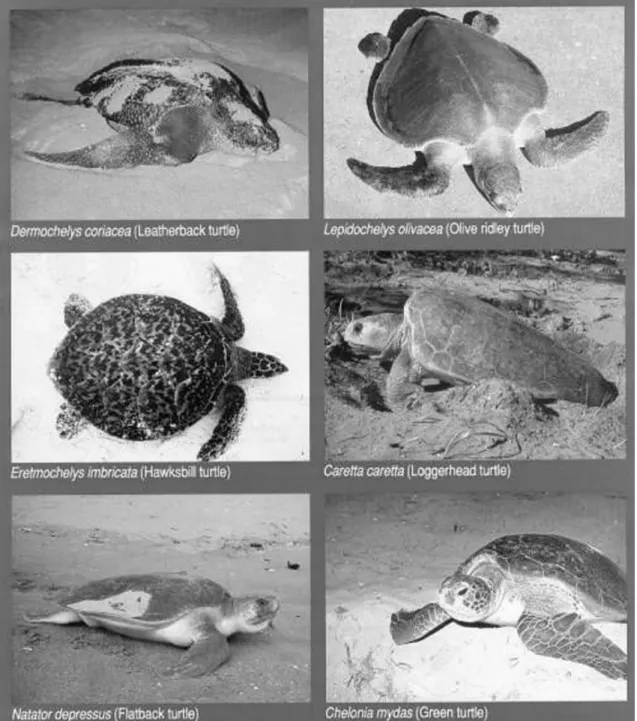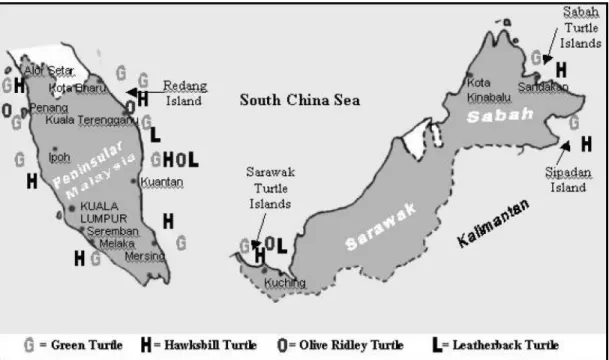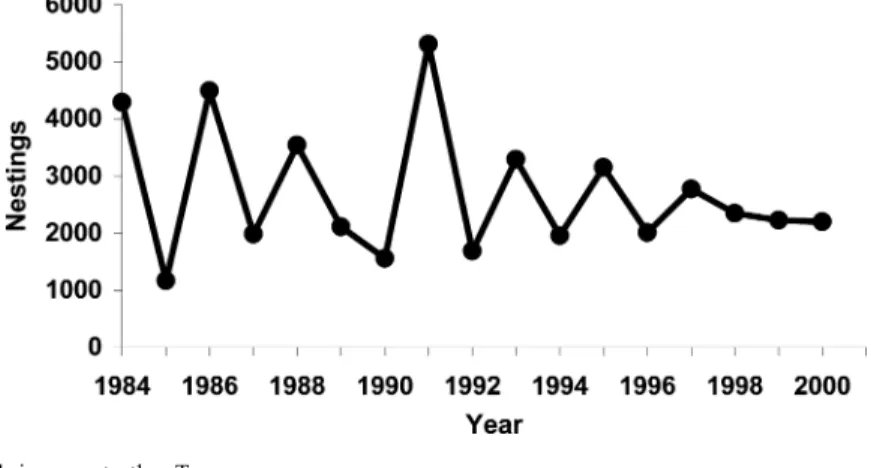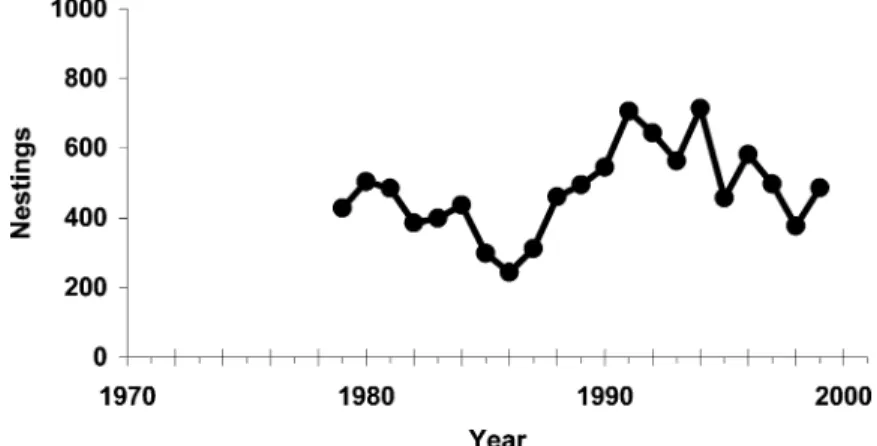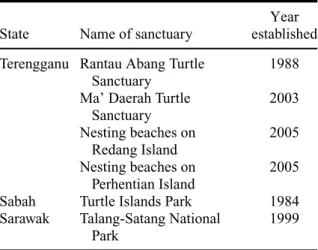Marine turtles in Malaysia: On the verge of extinction?
Eng-Heng Chan
Turtle Research and Rehabilitation Unit, Institute of Oceanography, Kolej Universiti Sains dan Teknologi Malaysia (KUSTEM), 21030 Kuala Terengganu, Malaysia
E-mail: ehchan@kustem.edu.my
Four species of marine turtles (leatherback, green turtle, hawksbill and olive ridley) are found in Malaysia. Current statistics indicate that the leatherback and olive ridley turtles are on the verge of extinction in Malaysia; while other species, excluding the green turtles of the Sabah Turtle Islands, are in steady decline. Consumptive utilization in the form of egg exploitation until recently, took place mainly in Terengganu. Turtles are also being used to promote tourism in Terengganu and Sabah. Population decline is attributed to a long history of egg exploitation, commercial hunting and harvesting of marine turtles in neighbouring countries, fishing mortality, loss of nesting habitats, marine pollution, negative impacts of tourism and the lack of a national strategy on marine turtle conservation. Marine turtle conservation efforts in Malaysia are not lacking, but need to be upgraded and coordinated. Legislation among the various states of Malaysia should be harmonized to ensure greater protection for these endangered animals. Existing egg incubation programmes should be expanded to secure a higher level of egg protection. More sanctuaries should be established in key nesting sites and Malaysia should join her neighbours in ratifying current regional instruments aimed at marine turtle conservation.
Keywords:nesting trends, population threats, utilization, management and conservation
Introduction
Marine turtles rank among the better-known sea creatures in Malaysia, with a conservation history dat-ing back to the 1950’s. They have been well studied and much has been written about them in the local media, popular magazines, as well as in scientific jour-nals (see Chan, 1991; Chan and Liew, 1996, 2002a; Chan and Shepherd, 2002; Liew, 1999). Notwith-standing, the survival of these animals, like many other wildlife, is threatened. Some species like the leatherback and olive ridley turtles are on the verge of extinction, while other species struggle to survive in the face of continued exploitation and other anthropogenic threats.
This chapter will provide a brief introduc-tion to the species of marine turtles found in Malaysia, current status of nesting density, nesting trends, utilization, causes of population decline, and
management and conservation measures under-taken locally and regionally to help restore the populations.
Malaysian species
Four of the seven extant species of marine turtles occur in Malaysia (Figures 1 and 2).
The leatherback turtle (Dermochelys coriacea) nests primarily on the mainland beaches of Tereng-ganu, along a 15 km stretch of beach centred in Rantau Abang. The green turtle (Chelonia mydas) is more widely distributed, with the most important nest-ing populations occurrnest-ing in the Sabah and Sarawak Turtle Islands. Other nesting beaches can be found in Terengganu (mainly in Redang and Perhentian Islands, Kemaman and Kerteh), Pahang (Chendor and Cherat-ing), Perak (Pantai Remis) and Sipadan Island in Sabah.
175
Aquatic Ecosystem Health & Management, 9(2):175–184, 2006. CopyrightC2006 AEHMS. ISSN: 1463-4988 print / 1539-4077 online
176 Chan / Aquatic Ecosystem Health and Management 9 (2006) 175–184
Figure 1.Marine turtles of Malaysia. Adapted from a poster by the Queensland Department of Environmental Heritage.
The hawksbill turtle (Eretmochelys imbricata) has only two remaining important nesting populations, in the Sabah Turtle Islands (principally Gulisaan Island) and Melaka, with remnant populations in Terengganu,
Johore and elsewhere. The nesting status of the olive ri-dley (Lepidochelys olivacea) is fragmentary, with iso-lated cases of nesting reported in the Sarawak Turtle Islands, Penang, Terengganu and Kelantan (Figure 2).
Chan / Aquatic Ecosystem Health and Management 9 (2006) 175–184 177
Figure 2. Marine turtle nesting sites in Malaysia.
Current population status
and nesting trends
The population status of marine turtles is measured by the number of nests produced by the various species per year, a figure that can be conveniently determined by counting the number of nests deposited on the nest-ing beaches. This figure does not provide an indication of the actual population size since it measures only the mature female turtles that ascend the beaches to lay be-tween four to six clutches of eggs per nesting season. The turtles do not nest every year, with each nesting cycle separated by an interval of two to eight years.
Except for the Sabah populations, most nesting trends are in decline. The most dramatic declines are exhibited in the leatherbacks, hawksbills and olive rid-leys of Terengganu where current nesting numbers in-dicate that these species are virtually extinct (Figures 3 to 5). Available records indicate that the leatherback population has plummeted from 10,000 annual nest-ings in the early 1950’s to less than a dozen in recent years (Chan, 1991, 2004; Chan and Liew, 1996, 2001). Although historical data is not available for the hawks-bill and olive ridleys of Terengganu, their declines are no less dramatic than the leatherbacks. Green turtle populations in Terengganu have not been monitored
sufficiently to provide a clear picture of the nesting trends, but anecdotal evidence suggests declines of over 80%. Current nesting density averages 2,000 per year (Figure 6).
Nesting trends in the green turtles of the Sarawak Turtle Islands over the last 30 years appear to be in equi-librium, with two to three thousand nestings occurring per year (Figure 7). However, in the early 50’s, nest-ings of over 20,000 per year were recorded, indicating a decline of over 90% (Tisen and Bali, 2000).
Only the green turtle populations of the Sabah Turtle Islands have staged a recovery, with current densities of over 8,000 nestings per year representing a three-fold increase over levels recorded in the early 1980’s (Figure 8). This remarkable recovery is attributed to bold conservation decisions made by the Sabah Gov-ernment more than 20 years ago in the 1970’s when the Turtle Islands were compulsorily acquired from private ownership to provide complete protection to the nest-ing turtles and their eggs on the islands. However, the hawksbill populations in Sabah have not fared as well and appear to have declined steadily over the last ten years (Figure 9). Currently, nesting density ranges from 400 to 500 per year. The other hawksbill nesting popu-lation of importance occurs in Melaka where over 250 nests per year can still be found (Figure 10).
178 Chan / Aquatic Ecosystem Health and Management 9 (2006) 175–184
Figure 3.Nesting trends in leatherback turtles, Terengganu.
Figure 4.Nesting trends in hawksbill turtles, Terengganu.
Chan / Aquatic Ecosystem Health and Management 9 (2006) 175–184 179
Figure 6. Nesting trends in green turtles, Terengganu.
Figure 7. Nesting trends in green turtles, Sarawak Turtle Islands.
180 Chan / Aquatic Ecosystem Health and Management 9 (2006) 175–184
Figure 9.Nesting trends in hawksbill turtles, Sabah Turtle Islands.
Utilization
Although marine turtles have been used for decades by the people of Southeast Asia in many different ways, utilization in Malaysia has traditionally cen-tered around egg exploitation and more recently, in the tourism and educational arenas. Widespread com-mercial egg collection in Terengganu took place un-til as recently as 2004 where the local government used to issue licenses to the local villagers by ten-der. The income generated has been estimated at no more than RM100,000 per year, approximately $27, 000 US., (Chan and Shepherd, 2002). However, com-mercial egg exploitation in the state has been curbed since 2005 when major nesting beaches were declared sanctuaries.
Figure 10.Nesting trends in hawksbill turtles, Melaka.
Turtle watching is popular as turtles are non-aggressive and can be watched at close range if the tourists are controlled. Tourists visit Selingaan Island in the Sabah Turtle Islands primarily for the purpose of watching nesting turtles and the release of hatch-lings. In Sipadan Island, Sabah, diving with the turtles constitutes one of the major attractions. A few hotels along the east coast of Peninsular Malaysia utilize turtle watching as one of their selling points. Recently, public educational components have been incorporated into turtle conservation projects. The long-term tagging and in-situ incubation project conducted by the Turtle Re-search and Rehabilitation Unit of Kolej Universiti Sains dan Teknologi Malaysia (KUSTEM) has developed a successful volunteer programme through which mem-bers of the public are given an insight and hands-on
Chan / Aquatic Ecosystem Health and Management 9 (2006) 175–184 181 experience in a grass-roots turtle conservation project
(Chan and Liew, 2002b). This idea has been adapted by the Fisheries Department in the Ma’Daerah Turtle Sanctuary in Terengganu where the public can spend a weekend at the sanctuary watching and interacting with the turtles.
Causes of population decline
A long history of intensive egg exploitation has been named as one of the major causes of population de-cline. In Terengganu and Sarawak where hatchery pro-grammes have been in place since the 50’s and 60’s, continued egg harvest for many decades has led to the failure to protect sufficient numbers of marine turtle eggs required for population maintenance. Government sanctioning of commercial sale of turtle eggs in the markets in Terengganu have also encouraged smug-gling of turtle eggs from places where its sale and ex-ploitation have been banned.
In Malaysia, the practice of hunting and slaughtering of turtles for their meat or other products does not exist. However, commercial harvesting of turtles in neigh-bouring countries can impact local populations since marine turtles are highly migratory. Satellite tracking studies have demonstrated that green turtles that nest in
Figure 11. Author measuring a green turtle carcass stranded in Chendering, Terengganu in April 2002.
Redang Island, Terengganu and the Sarawak Turtle Is-lands migrate to near-shore feeding grounds occurring in the territorial waters of countries bordering the South China Sea as well as the Sulu-Sulawesi Sea (Liew et al., 1995; Bali et al., 2002).
The fishing industry is well established in coastal areas where turtle nesting occurs. Fishing gear such as trawl nets, drift nets, fish traps, long lines, purse seines, ray nets (pukat pari), lift nets, and even beach seines have been identified to impact sea turtles (Chan and Liew, 2001). Rate of capture in Terengganu was high in the past where over 700 turtles were estimated to drown in trawl nets each year (Chan et al., 1988), com-pared to more recent estimates of 50 turtles drowning per year (Chan and Liew, 2001). Fishing mortality is corroborated by strandings of turtles (Figure 11) where a total of 188 carcasses attributed to incidental capture in fishing gear have been recovered from the beaches of Terengganu between 1990–95 (Ramli and Hiew, 1999). Fishing mortality occurs not only in inshore territorial waters, but in the high seas as well which are traversed by the turtles during their long-distance migrations be-tween feeding and nesting grounds.
Loss of nesting habitats is expected in Malaysia where prime beaches are being developed for tourism. Except in places where turtle sanctuaries have been
182 Chan / Aquatic Ecosystem Health and Management 9 (2006) 175–184 established (e.g., Sabah and Sarawak Turtle Islands;
Rantau Abang, Ma’Daerah and major nesting beaches in Perhentian and Redang Islands in Terengganu), beachfront development threatens other existing ing beaches. Pulau Upeh in Melaka, an important nest-ing site for the only remainnest-ing hawksbill population of importance in Peninsular Malaysia has also been re-cently sold to a private conglomerate for development (Kevin and Sharma, personal communication).
Marine pollution can degrade feeding grounds and impact marine turtles. There is ample evidence of pol-lution and persistent debris in the South China Sea (Law and Rahimi, 1986; Chan et al., 1996; Chan and Liew, 2003), although no studies have been conducted locally to determine the interactions. Organochlorine compounds, heavy metals, hydrocarbons and radionu-clides have been found in the eggs and tissues of sev-eral species of marine turtles in the US, Ascension Is-land and France, but their physiological effects are not known (National Research Council, 1990). Persistent debris is of serious concern as numerous cases of ac-cidental ingestion of plastic bags and entanglement in monofilament fishing line and discarded fishing nets have been documented (National Research Council, 1990).
Marine turtles can be used to promote tourism in a non-consumptive way. However, negative impacts become evident when guidelines for turtle conserva-tion are not adequately laid down or mandated. Over-development of fragile islands that provide nesting sites for marine turtles can quickly lead to the destruction of nesting as well as feeding habitats. Increased speedboat traffic is often associated increased mortalities of turtles caused by propeller hits. Activities such as snorkeling and scuba diving can be incompatible with turtles when tourists are ill informed and negatively impact turtles in the water by handling, grabbing, or riding them.
One of the causes of population decline can be at-tributed to lack of coordinated efforts between the var-ious agencies which undertake turtle conservation pro-grammes, and the lack of a national policy or strategic plan on marine turtle conservation.
Conservation and management
measures
The management and conservation of marine turtles comes under the purview of state governments, some of which have legislation specifically for this purpose. However, except for Sarawak which has updated con-servation measures under the Wildlife Protection
Or-dinance 1998 (Tisen and Bali, 2000; Under this ordi-nance, exploitation and trade in all marine turtles, their eggs and any derivative or their parts, are prohibited), and Sabah which prohibits commercial exploitation of marine turtles and their eggs, legislation in the other states is inadequate. There is no uniformity and in most of Peninsular Malaysia, all marine turtle eggs (except leatherback eggs in Terengganu and Pahang) are freely and legally traded in the local markets, except in Perak and Melaka. There is thus a need at the federal level to review and harmonize all existing state legislature into a new and effective legislation for adoption by all states.
Two fisheries laws are currently in effect for the off-shore protection of marine turtles (Chan, 1993). The Fisheries Regulations (Prohibition of Fishing Meth-ods) 1985, Amendment 1989 bans the use of large mesh (exceeding 24/5 cm) sunken gill nets for the cap-ture of rays. The Fisheries (Prohibited Areas) (Rantau Abang) Regulations 1991 created an offshore sanctuary in Rantau Abang where fishing activities are regulated during the nesting seasons. Enforcement is important if these regulations are to be effective.
Malaysia has a long history of turtle egg protec-tion programmes, compared to other South East Asian countries. Egg incubation in hatcheries was initiated in the early 1950’s in Sarawak and 1960’s in Terengganu and Sabah, 1971 in Pahang and early 1990’s in Melaka and Perak. Except for the Sabah populations, most of these efforts have not been manifested in population recovery because of inadequate numbers of eggs pro-tected. Other factors, such as incubation of the eggs at temperatures leading to all male, or all female hatch-ings, and loss of adult populations of turtles through fishing and pollution, are also serious issues. However, Sabah started protecting close to 100% of the green turtle eggs deposited in the early 1970’s (see section on nesting trends) followed by Sarawak in 1999. Level of egg protection in Terengganu has increased signif-icantly since 2005 when all major nesting beaches in the state were declared sanctuaries. Turtle conserva-tionists advocate that in healthy populations, at least 70% of the eggs deposited must be incubated to ensure population sustainability. In impoverished populations, it is imperative that 100% of the eggs be protected to provide hope for population recovery.
Turtle sanctuaries have been established at some key nesting locations shown in Table 1. In order to secure all nesting sites of significance and to prevent them from further degradation, more sanctuaries should be established at the locations shown in Table 2. As long as important nesting sites are not accorded sanctuary
Chan / Aquatic Ecosystem Health and Management 9 (2006) 175–184 183
Table 1.Turtle sanctuaries that have been established in Malaysia.
State Name of sanctuary
Year established Terengganu Rantau Abang Turtle
Sanctuary
1988 Ma’ Daerah Turtle
Sanctuary 2003 Nesting beaches on Redang Island 2005 Nesting beaches on Perhentian Island 2005
Sabah Turtle Islands Park 1984
Sarawak Talang-Satang National Park
1999
status, development will take place and render them unsuitable for turtle nesting.
Public education and awareness is often cited as an important issue in endangered species conserva-tion. The Malaysian public is quite well informed of the status of marine turtles in the country as the local media has provided ample coverage. Other activities such as long term turtle volunteer programmes, turtle camps and other awareness programmes conducted by the Fisheries Department, World Wide Fund for Na-ture Malaysia and the Turtle Research and Rehabili-tation Unit of KUSTEM have helped increase public awareness on marine turtles.
At the regional level, some initiatives have been made to develop regional marine conservation pro-grammes. The Turtle Islands Heritage Protected Area (TIHPA), a transboundary protected area in the Sulu Sea was established in 1996 between Sabah and the Philippines to jointly manage the large turtle popu-lations occurring there. The Memorandum of Under-standing on ASEAN Sea Turtle Conservation and Pro-tection was signed in 1997 while the Memorandum of Understanding on the Conservation and Management of Marine Turtles and their Habitats of the Indian Ocean
Table 2.Turtle nesting sites that should be declared turtle sanctuaries (after Sharma and Hiew, 2003).
State Name of sanctuary
Terengganu Setiu River lagoon and river mouth Pahang Beach at Cherating
Perak Segari Beach
Melaka Pulau Upeh and Tanjong Tuan Beach at Pengkalan Balak
and Southeast Asia was concluded in 2001. Malaysia has yet to ratify the latter. At the global level, the Con-vention on International Trade in Endangered Species of Wild Fauna and Flora (CITES), of which Malaysia is party, serves to curb international trade of marine turtles and their parts.
Acknowledgements
The author is indebted to the Fisheries Department of Malaysia, Sabah Parks Authority, the Wildlife De-partment of Sabah and the Sarawak Forestry Depart-ment for providing statistics on turtle nesting density. Figures and graphs were produced with the help of Mr. Jeremy Liew Jee Weng. Professor Fatimah Yusoff of Universiti Putra Malaysia is thanked for her patience in awaiting the preparation of this chapter.
References
Bali, J. H., Liew, H. C., Chan, E. H., Tisen, O. B., 2002. Long dis-tance migration of green turtles from the Sarawak Turtle Islands, Malaysia. pp. 32–33. In: A. Mosier, A. Foley, B. Brost (Eds.), Proceedings of the Twentieth Annual Symposium on Sea Turtle Biology and Conservation, 2000 Feb 29–Mar 4.: NOAA Tech. Memo NMFS-SEFSC-447. Orlando, Florida.
Chan, E. H., 2004. Turtles in trouble. Siri Syarahan Inaugural KUSTEM: 7(2004). ISBN 983-2888-07-7. Kuala Terengganu, Malaysia.
Chan, E. H., 1993. Interactions between fisheries and sea turtles. Fishmail 5(3), 12–15.
Chan, E. H., 1991. Sea Turtles. In: R. Kiew (Ed.),The State of Nature Conservation in Malaysia. pp. 120–134. Malayan Nature Society and International Development and Research Center of Canada. Kuala Lumpur, Malaysia.
Chan, E. H., Liew, H. C., 2003. Tar ball at Terengganu’s Coast. Fi-nal report submitted to ExxonMobil Exploration and Produc-tion Malaysia Inc. under Agreement No. PCP 1104. Faculty of Science and Technology, Kolej Universiti Sains dan Teknologi, Malaysia.
Chan, E. H., Liew, H. C., 2002a. Interactions between fishing gear and sea turtles in Terengganu. Paper presented at the Asian-Japan Workshop on Cooperative Sea Turtle Research and Conservation. 2001 Dec 11–13.: Phuket Marine Biological Center, Thailand. Chan, E. H., Liew, H. C., 2002b. Raising funds and public
aware-ness in sea turtle conservation in Malaysia. p 25. In: A. Mosier, A. Foley, B. Brost (Eds.), Proceedings of the Twentieth Annual Symposium on Sea Turtle Biology and Conservation, 2000 Feb 29–Mar 4.: NOAA Tech. Memo NMFS-SEFSC-447, Orlando, Florida.
Chan, E. H., Liew, H. C., 2001. Sea Turtles. In: J. E. Ong, W. K. Gong (Eds.),The Encyclopedia of Malaysia, V. 6: The Seas,pp. 74–75. Editions Didier Millet, Kuala Lumpur, Malaysia.
Chan, E. H., Liew, H. C., 1999. Research, conservation and edu-cational activities of the Sea Turtle Research Unit (SEATRU). pp. 235–244. In: M. T. N. Nasir, A. K. A. Karim, M. N. Ramli (Eds.), Report of the SEAFDEC—ASEAN Regional Workshop
184 Chan / Aquatic Ecosystem Health and Management 9 (2006) 175–184
on Sea Turtle Conservation and Management, 1999 July 26–28.: MFRDMD, SEAFDEC, Kuala Terengganu, Malaysia
Chan, E. H., Liew, H. C., 1996. Decline of the leatherback population in Terengganu, Malaysia, 1956–1995. Chelonian Conservation and Biology 2(2), 196–203.
Chan, E. H., Shepherd, C. R., 2002. Marine Turtles: The Scenario in Southeast Asia. Tropical Coasts. 9(2), 38–43.
Chan, E. H.,. Liew H. C., Der, F. P., 1996. Beached debris in Pulau Redang and a mainland beach in Terengganu. pp. 99–108. In: A. Sasekumar (Ed.), Proc. 13th Annual Seminar of the Malaysian Society of Marine Sciences on Impact of Development and Pol-lution on the Coastal Zone in Malaysia. 1996 Oct 26.: Kuala Lumpur, Malaysia.
Chan, E. H., Liew H. C., Mazlan, A. G., 1988. The incidental capture of sea turtles in fishing gear in Terengganu, Malaysia. Biological Conservation. 43(1), 1–7.
Law, A. T., Rahimi, Y., 1986. Hydrocarbon distribution in the South China Sea. In: A. K. M. Mohsin, M. Ibrahim, M. A. Ambak (Eds.),Expedisi Matahari ’85: A Study on the Offshore Wa-ters of the Malaysian EEZ. pp. 93–100. Universiti Pertanian, Malaysia.
Liew, H. C., 1999. Status of marine turtle conservation and research in Malaysia. pp. 51–56. In: I. Kinan,. (Ed.), Proceedings of the Western Pacific Sea Turtle Cooperative Research &
Manage-ment Workshop. 2002 Feb. 5–8.: Western Pacific Regional Fish-ery management Council, Honolulu, Hawaii.
Liew, H. C., Chan, E. H., Papi, P., Luschi, P., 1995. Long distance migration of green turtles from Redang Island, Malaysia. pp. 73– 75.The need for regional cooperation in sea turtle conservation.
Proc. International Congress of Chelonian Conservation. 1995 July 6–10: Gonfaron, France.
National Research Council (US), Committee on Sea Turtle Conser-vation, 1990.Decline of the sea turtles: causes and prevention.
National Academy of Sciences, USA.
Ramli, M. N., Hiew, K. W. P., 1999. Marine turtle management, conservation and protection programme in Malaysia. pp. 122– 129. In: Report of the SEAFDEC–ASEAN Regional Workshop on Sea Turtle Conservation and Management, 1999 July 26–28.: Kuala Terengganu, Malaysia.
Sharma, D., Hiew, K., 2003. Recommendations for change in turtle conservation in Malaysia. Paper presented at the Roundtable on the Conservation of Turtles in Malaysia, 2003 May 27. Maritime Institute of Malaysia (MIMA).
Tisen, O. B., Bali, J., 2000. Current status of marine turtle conserva-tion programmes in Sarawak, Malaysia. pp. 12–14. In: A. Mosier, A. Foley, B. Brost (Eds.), Proceedings of the Twentieth Annual Symposium on Sea Turtle Biology and Conservation, 2000 Feb 29–4 Mar.: NOAA, Orlando, Florida.
